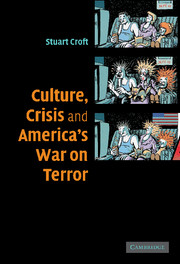Book contents
- Frontmatter
- Contents
- List of figures
- Acknowledgements
- Introduction
- 1 Disrupting meaning
- 2 Deconstructing the second American 9/11
- 3 The decisive intervention
- 4 The institutionalisation and stabilisation of the policy programme
- 5 Acts of resistance to the ‘war to terror’
- 6 The discourse strikes back
- 7 Conclusion
- Select bibliography
- Index
4 - The institutionalisation and stabilisation of the policy programme
Published online by Cambridge University Press: 15 December 2009
- Frontmatter
- Contents
- List of figures
- Acknowledgements
- Introduction
- 1 Disrupting meaning
- 2 Deconstructing the second American 9/11
- 3 The decisive intervention
- 4 The institutionalisation and stabilisation of the policy programme
- 5 Acts of resistance to the ‘war to terror’
- 6 The discourse strikes back
- 7 Conclusion
- Select bibliography
- Index
Summary
Introduction
By early 2002, a foundational myth had been constructed out of the crisis of the second American 9/11, and a decisive intervention had been articulated – one that achieved its fullest expression in the President's State of the Union address in January. In this new understanding, America had not suffered a one-off disaster on 11 September 2001, the act of criminals; rather, the collective under standing was that the attacks of that day were an illustration of the ongoing threat in a long-term war. As President Bush declared in a speech in January 2002:
I say terrorist attack because we're still under attack. They still want to come after us. These are evil people that are relentless in their desire to hurt those who love freedom. And since we're the bastion of freedom, the beacon of freedom, we're their target. And we're going to respond, and we're going to deal with it by working together.
The discourse of the ‘war on terror’ that underlined this statement was uncontested in mainstream political and cultural life in the United States. The ‘war on terror’ as a policy programme was well underway.
A crisis is understood in specific ways through a decisive intervention that leads to the construction of a meta-narrative, which frames a policy programme that is institutionalised in the discourse and practices of state policy and, in the case of the contemporary United States, in popular culture.
- Type
- Chapter
- Information
- Culture, Crisis and America's War on Terror , pp. 122 - 164Publisher: Cambridge University PressPrint publication year: 2006



